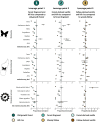Land-use trajectories for sustainable land system transformations: Identifying leverage points in a global biodiversity hotspot
- PMID: 35165148
- PMCID: PMC8851510
- DOI: 10.1073/pnas.2107747119
Land-use trajectories for sustainable land system transformations: Identifying leverage points in a global biodiversity hotspot
Abstract
Sustainable land-system transformations are necessary to avert biodiversity and climate collapse. However, it remains unclear where entry points for transformations exist in complex land systems. Here, we conceptualize land systems along land-use trajectories, which allows us to identify and evaluate leverage points, i.e., entry points on the trajectory where targeted interventions have particular leverage to influence land-use decisions. We apply this framework in the biodiversity hotspot Madagascar. In the northeast, smallholder agriculture results in a land-use trajectory originating in old-growth forests and spanning from forest fragments to shifting hill rice cultivation and vanilla agroforests. Integrating interdisciplinary empirical data on seven taxa, five ecosystem services, and three measures of agricultural productivity, we assess trade-offs and cobenefits of land-use decisions at three leverage points along the trajectory. These trade-offs and cobenefits differ between leverage points: Two leverage points are situated at the conversion of old-growth forests and forest fragments to shifting cultivation and agroforestry, resulting in considerable trade-offs, especially between endemic biodiversity and agricultural productivity. Here, interventions enabling smallholders to conserve forests are necessary. This is urgent since ongoing forest loss threatens to eliminate these leverage points due to path dependency. The third leverage point allows for the restoration of land under shifting cultivation through vanilla agroforests and offers cobenefits between restoration goals and agricultural productivity. The co-occurring leverage points highlight that conservation and restoration are simultaneously necessary to avert collapse of multifunctional mosaic landscapes. Methodologically, the framework highlights the importance of considering path dependency along trajectories to achieve sustainable land-system transformations.
Keywords: Madagascar; agroforestry; conservation; path dependency; restoration.
Copyright © 2022 the Author(s). Published by PNAS.
Conflict of interest statement
The authors declare no competing interest.
Figures




Similar articles
-
Complementary ecosystem services from multiple land uses highlight the importance of tropical mosaic landscapes.Ambio. 2023 Oct;52(10):1558-1574. doi: 10.1007/s13280-023-01888-3. Epub 2023 Jun 7. Ambio. 2023. PMID: 37286920 Free PMC article.
-
Producing wood at least cost to biodiversity: integrating Triad and sharing-sparing approaches to inform forest landscape management.Biol Rev Camb Philos Soc. 2021 Aug;96(4):1301-1317. doi: 10.1111/brv.12703. Epub 2021 Mar 4. Biol Rev Camb Philos Soc. 2021. PMID: 33663020 Review.
-
Selective‐logging and oil palm: multitaxon impacts, biodiversity indicators, and trade‐offs for conservation planning.Ecol Appl. 2014;24(8):2029-49. Ecol Appl. 2014. PMID: 29185670
-
Win-win opportunities combining high yields with high multi-taxa biodiversity in tropical agroforestry.Nat Commun. 2022 Jul 26;13(1):4127. doi: 10.1038/s41467-022-30866-8. Nat Commun. 2022. PMID: 35882849 Free PMC article.
-
Keeping pace with forestry: Multi-scale conservation in a changing production forest matrix.Ambio. 2020 May;49(5):1050-1064. doi: 10.1007/s13280-019-01248-0. Epub 2019 Sep 16. Ambio. 2020. PMID: 31529355 Free PMC article. Review.
Cited by
-
Agroforestry in Madagascar: past, present, and future.Agrofor Syst. 2024;98(6):1659-1680. doi: 10.1007/s10457-024-00975-y. Epub 2024 May 10. Agrofor Syst. 2024. PMID: 39086741 Free PMC article. Review.
-
Madagascar's fire regimes challenge global assumptions about landscape degradation.Glob Chang Biol. 2022 Dec;28(23):6944-6960. doi: 10.1111/gcb.16206. Epub 2022 May 18. Glob Chang Biol. 2022. PMID: 35582991 Free PMC article.
-
Complementary ecosystem services from multiple land uses highlight the importance of tropical mosaic landscapes.Ambio. 2023 Oct;52(10):1558-1574. doi: 10.1007/s13280-023-01888-3. Epub 2023 Jun 7. Ambio. 2023. PMID: 37286920 Free PMC article.
-
Enhancing economic multifunctionality without compromising multidiversity and ecosystem multifunctionality via forest enrichment.Sci Adv. 2024 Oct 25;10(43):eadp6566. doi: 10.1126/sciadv.adp6566. Epub 2024 Oct 23. Sci Adv. 2024. PMID: 39441929 Free PMC article.
-
Land-use change interacts with island biogeography to alter bird community assembly.Proc Biol Sci. 2024 Mar 13;291(2018):20232245. doi: 10.1098/rspb.2023.2245. Epub 2024 Mar 13. Proc Biol Sci. 2024. PMID: 38471555 Free PMC article.
References
-
- Leclère D., et al. , Bending the curve of terrestrial biodiversity needs an integrated strategy. Nature 585, 551–556 (2020). - PubMed
-
- Freeman O. E., Duguma L. A., Minang P. A., Operationalizing the integrated landscape approach in practice. Ecol. Soc. 20, 24 (2015).
-
- Kremen C., Merenlender A. M., Landscapes that work for biodiversity and people. Science 362, eaau6020 (2018). - PubMed
MeSH terms
LinkOut - more resources
Full Text Sources

